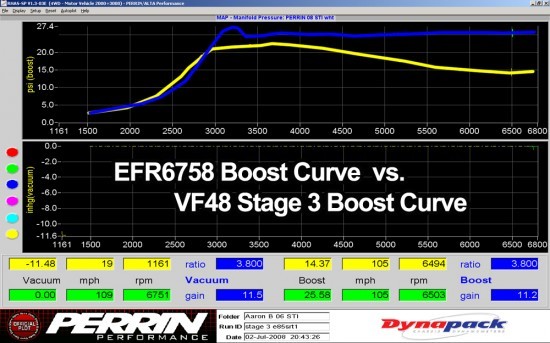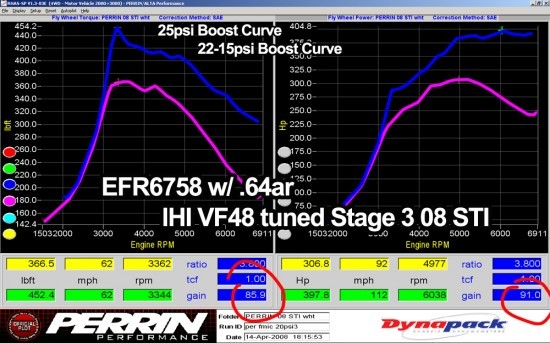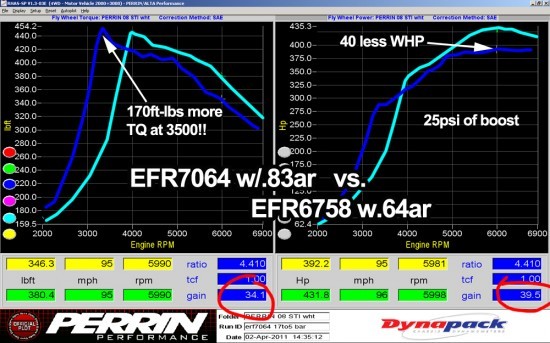Category : Dyno Test & Tune
Back to Blog
Share This
CRV/BOV Testing
During my dyno time i spent about 15 runs testing the Bov. I tested the stock cap, all the springs, and our own BOV along with 1 run of no BOV. I spent a lot of time looking over the data and comparing my data channel i made called turbo rate of change. After all the testing there wasn't a very drastic change in rate from one BOV to the next. There was a difference in the stock spring and modded CRV cap compared to no bov, but it wasn't that much different. Here is a screen shot of what i would see. I took my PERRIN BOV and left it installed with the BW CRV. I had one vacuum hose setup that teed from one to the other. The PERRIN bov can be "turned off" by screwing the cap down all the way. That allowed me to test one the the other easily on the road. So what i found was compressor surge all of a sudden. I spent the next week messing around with things after work trying to figure out what was causing it.Problem Found.....
Then i had an opportunity to test out some new tuning methods for the stock ECU and i re-installed it. The stock ECU has all the normal Check Engine lights enabled and after i installed it i found that i had a CEL for a TGV housing (Bank2) fault. For those who don't know what they are the TGV housings are little butterfly valves that block off about 66% of the intake plenum to speed up air at cold start (and other times on the 08+ cars). My Cosworth ECU has no check engine light or fault detection for this so i had no idea! The one good thing,when it was plugged in, the Cosworth ECU defaults to them being open all the time so most likely the Bank 2 housing was opened for some period of time. The problem is when there is no power to the TGV, airflow can close it over time. Well funny thing is i left this unplugged when i cleaned my fuel injectors right after the EFR7064 was installed and just before i had to send it back. Why does this matter? This is a huge variable and for sure effected my dyno results for the worse. With only half my engine getting limited air flow during the dyno runs the results were pretty damn good. Below is a picture of the TGV housing and it being partially closed and one that is ported out.
Dyno Time
Needless to say, i didn't know about the TGV issue and i still dynoed the car and had good results. I had tons of really cool graphs all ready to show off, but most all of them are a waste as there is more HP on tap that i found. But below are a couple to give you an idea. I dynoed the car 1 week after some road tuning to test a few things out like boost control with the PERRIN Prototype push/pull wastegate. I did the same tuning as i did on the other turbos. 1.2, 1.5, 1.7 and 1.9bar of boost. I knew that this was a much smaller turbo, and less efficient at higher airflow, so i expected to remove some fuel. On the dyno i had to remove about 8% of the fuel to get my AFR back to where it was on the other runs with the other EFR's. The weird part was i was getting a litte knock like i hadn't had before. It wasn't bad, just something elevated compared to the last runs. Remember at this point i had no idea my Bank2 TGV housings were closed. First off the response is almost exactly like the OEM turbo. Check out this graph. What is amazing is the TQ and HP blow the stock turbo out of the water. Mostly because i was running more boost almost everywhere compared to stock. With the stock turbo this is not possible, but with the the EFR6758 and its larger capacity, it is! Now during all these runs i was seeing 140K turbo speed which is way way off the compressor map. This could partially be from the closed TGV housing, but more likely from pushing this tiny turbo too much. Above you see a typical stock STI turbo running almost 100% wastegate Duty Cycle. You get the super smooth 20-22psi peak boost dropping to about 15 at redine. These turbos are very small and somewhat safe when maxed out because there is no danger of overboost at higher RPM.
Below you see the TQ and HP the EFR6758 does over the stock STI turbo. We are able to run more boost and in turn make more HP and TQ.
Above you see a typical stock STI turbo running almost 100% wastegate Duty Cycle. You get the super smooth 20-22psi peak boost dropping to about 15 at redine. These turbos are very small and somewhat safe when maxed out because there is no danger of overboost at higher RPM.
Below you see the TQ and HP the EFR6758 does over the stock STI turbo. We are able to run more boost and in turn make more HP and TQ.
 I experienced was compressor surge during full throttle from 3000-4500 or so. This really only happened from 22psi to 30psi. We see this all the time on the stock turbo when its pushed so i expected it to happen. It wasn't bad enough to effect boost or fueling, it was more an audible thing. I could see my MAF reading waver a bit, but that is about it. This is a common thing we hear customers call about. They think its their BOV or the wastegate chattering or chipmunks or you name it. Its simply compressor surge.
I was overall pretty happy with the results.
I suspect that the TGV was closed during this dyno session after my discovery last week. You could imagine how this would be if one side is opened and the other side is closed only letting 33% air flow through it. Also imagine if they were both open!
One really weird thing is the compressor surge (from lifting) i was constantly getting. From 0-10psi the CRV would blow off like normal. But from 14psi on up it was constantly surging. Like i said, i spent hours diagnosing this. So first off i swapped the Compressor cover back to one i bored out the CRV hole on. This actually improved the surging a bit, but still was pretty bad at higher boost. Looking back the one thing that could have been causing this is that TGV housing being closed causing a strange vacuum in the intake manifold.
This last weekend when i figured this TGV crap out, i plugged in the TGV motor and the stock ECU to ensure there were no other problems. I reinstalled the Cosworth Ecu and went out and did some pulls on the road. Guess what, lean lean lean! But ZERO knock. I had CL fueling turned on and it was adding back in 8% more fuel! This is 8% more fuel needed to run the turbo at 25psi, and with more fuel means more air flow. You could argue 8% more HP which should push this close to 440WHP! The other thing i found was turbo speed was much higher. On the dyno i was seeing 135-142K rpm, and on the road after i fixed the TGV housing issue, i am seeing 152K!!! These numbers are all way off the chart and while its most likely not something BW recommends, it does make great power.
Here is a comparison of the EFR7064 and 6758 at 25psi. The EFR7064 suffered from the stock actuator blowing open. This turbo is one that Borg Warner wanted back right after i dynoed it, so i never had a chance to install our Push/Pull WG Actuator.
I experienced was compressor surge during full throttle from 3000-4500 or so. This really only happened from 22psi to 30psi. We see this all the time on the stock turbo when its pushed so i expected it to happen. It wasn't bad enough to effect boost or fueling, it was more an audible thing. I could see my MAF reading waver a bit, but that is about it. This is a common thing we hear customers call about. They think its their BOV or the wastegate chattering or chipmunks or you name it. Its simply compressor surge.
I was overall pretty happy with the results.
I suspect that the TGV was closed during this dyno session after my discovery last week. You could imagine how this would be if one side is opened and the other side is closed only letting 33% air flow through it. Also imagine if they were both open!
One really weird thing is the compressor surge (from lifting) i was constantly getting. From 0-10psi the CRV would blow off like normal. But from 14psi on up it was constantly surging. Like i said, i spent hours diagnosing this. So first off i swapped the Compressor cover back to one i bored out the CRV hole on. This actually improved the surging a bit, but still was pretty bad at higher boost. Looking back the one thing that could have been causing this is that TGV housing being closed causing a strange vacuum in the intake manifold.
This last weekend when i figured this TGV crap out, i plugged in the TGV motor and the stock ECU to ensure there were no other problems. I reinstalled the Cosworth Ecu and went out and did some pulls on the road. Guess what, lean lean lean! But ZERO knock. I had CL fueling turned on and it was adding back in 8% more fuel! This is 8% more fuel needed to run the turbo at 25psi, and with more fuel means more air flow. You could argue 8% more HP which should push this close to 440WHP! The other thing i found was turbo speed was much higher. On the dyno i was seeing 135-142K rpm, and on the road after i fixed the TGV housing issue, i am seeing 152K!!! These numbers are all way off the chart and while its most likely not something BW recommends, it does make great power.
Here is a comparison of the EFR7064 and 6758 at 25psi. The EFR7064 suffered from the stock actuator blowing open. This turbo is one that Borg Warner wanted back right after i dynoed it, so i never had a chance to install our Push/Pull WG Actuator.
 And here is the HP graphs of that comparison.
And here is the HP graphs of that comparison.
 Its really makes me mad that this happened. Normally I do a perfect job ensureing my cars tune before and after. Making sure that variables don't play into results. Like, i always do a boost leak check and a few other little things, recalibrate my Wideband, to eliminate as many possibilities as i can. Look for a retest on this turbo with the TGV's wide open making tons of power!
Its really makes me mad that this happened. Normally I do a perfect job ensureing my cars tune before and after. Making sure that variables don't play into results. Like, i always do a boost leak check and a few other little things, recalibrate my Wideband, to eliminate as many possibilities as i can. Look for a retest on this turbo with the TGV's wide open making tons of power!


